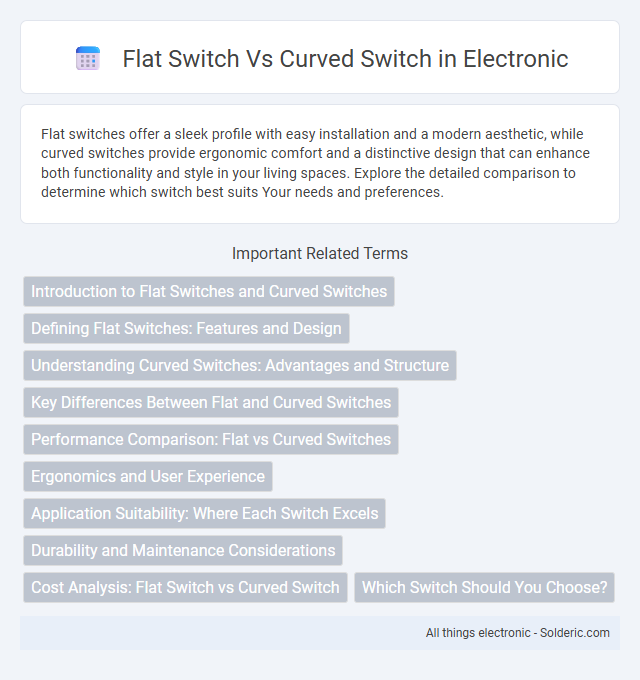Flat switches offer a sleek profile with easy installation and a modern aesthetic, while curved switches provide ergonomic comfort and a distinctive design that can enhance both functionality and style in your living spaces. Explore the detailed comparison to determine which switch best suits Your needs and preferences.
Comparison Table
| Feature | Flat Switch | Curved Switch |
|---|---|---|
| Design | Flat surface, minimalistic look | Ergonomic curved shape, stylish appearance |
| User Comfort | Standard touch, less ergonomic | Improved grip and tactile comfort |
| Installation | Simple mounting on flat surfaces | May require specific mounting due to curvature |
| Durability | Typically robust and straightforward | Durability depends on design, may be less robust |
| Cost | Generally lower cost | Usually higher due to complex design |
| Applications | Common in residential and commercial use | Preferred in modern, ergonomic setups |
Introduction to Flat Switches and Curved Switches
Flat switches feature a sleek, linear design that integrates seamlessly with modern minimalist decor, offering straightforward operation and aesthetics. Curved switches provide ergonomic benefits by conforming to the natural curve of the finger, enhancing user comfort and tactile feedback during use. Both switch types utilize advanced electrical contacts to ensure reliable performance, with flat switches often preferred for flush mounting, while curved switches excel in handheld or frequently accessed devices.
Defining Flat Switches: Features and Design
Flat switches feature a sleek, minimalistic design with a smooth, level surface that enhances modern aesthetics and ease of cleaning. Their compact form factor allows for seamless integration into various interior styles while providing efficient tactile feedback for user interaction. You can expect flat switches to offer both functional reliability and contemporary elegance, making them a popular choice for smart home installations and upgrades.
Understanding Curved Switches: Advantages and Structure
Curved switches feature a bent rail design that enables smoother train transitions and reduces wear on wheels and tracks, enhancing overall efficiency and safety. Their structure distributes forces more evenly across rails, minimizing maintenance needs and prolonging infrastructure lifespan. You benefit from improved ride comfort and lower operational costs when utilizing curved switches in rail transport systems.
Key Differences Between Flat and Curved Switches
Flat switches feature a streamlined, low-profile design that blends seamlessly with modern surfaces, offering a minimalist aesthetic and ease of cleaning. Curved switches, on the other hand, provide an ergonomic contour that enhances tactile feedback and visual appeal, often preferred for decorative or vintage-inspired interiors. Your choice between flat and curved switches impacts both functionality and style, aligning with the specific needs of usability and design preferences.
Performance Comparison: Flat vs Curved Switches
Flat switches offer a consistent and uniform actuation force, which enhances precision and responsiveness in rapid key presses. Curved switches, designed ergonomically to match finger contours, can reduce finger fatigue during extended typing sessions by promoting natural finger movement. Your choice between flat and curved switches should align with whether you prioritize speed and accuracy or comfort and prolonged use performance.
Ergonomics and User Experience
Flat switches offer a minimalist design that can reduce finger strain by providing a consistent surface, enhancing comfort during repetitive use. Curved switches conform to the natural arc of your fingers, improving typing accuracy and reducing fatigue over extended periods. Choosing the right switch shape greatly influences ergonomic support and overall user experience based on your hand posture and typing style.
Application Suitability: Where Each Switch Excels
Flat switches excel in compact electronic devices and wearable technology due to their low-profile design, which saves space and enhances portability. Curved switches are ideal for ergonomic applications such as gaming controllers and automotive dashboards, where natural finger placement and tactile feedback improve user experience. Both switch types optimize input precision and comfort based on the specific functional requirements of the device.
Durability and Maintenance Considerations
Flat switches typically offer greater durability due to their streamlined design, which minimizes mechanical wear and reduces the likelihood of debris accumulation. Curved switches may require more frequent maintenance as their shape can trap dust and dirt, potentially leading to performance issues over time. Your choice should reflect how much maintenance effort you are willing to invest and the environmental conditions where the switch will be used.
Cost Analysis: Flat Switch vs Curved Switch
Flat switches generally offer a lower cost due to simpler manufacturing processes and reduced material usage compared to curved switches. Curved switches involve more complex design and production steps, leading to higher expenses in tooling and assembly. When evaluating budget constraints, flat switches provide a cost-effective solution without compromising basic functionality, making them ideal for large-scale or budget-sensitive projects.
Which Switch Should You Choose?
Choosing between a flat switch and a curved switch depends on your ergonomic preferences and the specific application. Flat switches offer a minimalist design and are easier to clean, making them ideal for sleek, modern setups or environments where hygiene is a priority. Curved switches provide a more tactile, comfortable feel, reducing finger strain during repetitive use, which benefits users seeking enhanced comfort and precision in everyday tasks.
flat switch vs curved switch Infographic

 solderic.com
solderic.com